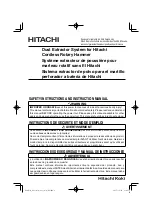
Hammer drilling operation (Fig. 15)
CAUTION:
When the bit begins to break through concrete or if
the bit strikes reinforcing rods embedded in concrete,
the tool may react dangerously. Maintain good
balance and safe footing while holding the tool
firmly with both hands to prevent dangerous reaction.
Set the change lever and the shift lever to the
symbol. Position the bit at the location for the
hole, then pull the trigger. Do not force the tool.
Light pressure gives best results. Keep the tool
in position and prevent it from slipping away from the
hole.
Do not apply more pressure when the hole becomes
clogged with chips or particles. Instead, run the
tool at an idle, then remove from the hole. By
repeating this several times, the hole will be cleaned
out.
Torque limiter
The torque limiter will actuate when a certain torque
level is reached. The motor will disengage from the
output shaft. When this happens, the bit will stop
turning.
CAUTION:
As soon as the torque limiter actuates, switch off the
tool immediately. This will help prevent prema-
ture wear of the tool.
Chipping/Scaling/Demolition (Fig. 16)
Set the change lever and the shift lever to the
symbol. Hold the tool firmly with both hands.
Turn the tool on and apply slight pressure on the
tool so that the tool will not bounce around,
uncontrolled. Pressing very hard on the tool will
not increase the efficiency.
Drilling operation (Fig. 17)
Use the optional drill chuck assembly. When installing
it, refer to ‘‘Installing or removing drill bit’’ described on
the previous page. You can drill up to 13 mm diameter
in metal and up to 30 mm diameter in wood.
Set the change lever and the shift lever to the
symbol.
• Drilling in wood
When drilling in wood, best results are obtained with
wood drills equipped with a guide screw. The guide
screw makes drilling easier by pulling the bit into the
workpiece.
• Drilling in metal
To prevent the bit from slipping when starting a hole,
make an indentation with a centerpunch and ham-
mer at the point to be drilled. Place the point of the
bit in the indentation and start drilling.
Use a cutting lubricant when drilling metals. The
exception is brass which should be drilled dry.
CAUTION:
• Pressing excessively on the tool will not speed
up the drilling. In fact, this excessive pressure will
only serve to damage the tip of your bit, decrease
the tool performance and shorten the service
life of the tool.
• Never use ‘‘rotation with hammering’’ when the drill
chuck assembly is installed on the tool. The
drill chuck assembly may be damaged.
Depth gauge (Fig. 18)
The depth gauge is convenient for drilling holes of
uniform depth. Loosen the clamp screw and adjust
the depth gauge to the desired depth. After adjusting,
tighten the clamp screw firmly.
NOTE:
The depth gauge cannot be used at the position
where the depth gauge strikes against the gear
housing/motor housing.
Indicator lamp (Fig. 19)
The green power-ON indicator lamp lights up when
the tool is switched ON. If the indicator lamp is lit
but the tool does not start, the carbon brushes
may be worn out, or the electric circuit or the motor
may be defective. If the indicator lamp does not light
up and the tool does not start, the ON/OFF
switch or the mains cord may be defective.
The red service indicator lamp lights up when the
carbon brushes are nearly worn out to indicate that
the tool needs servicing. After approx. 8 hours of
use, the motor will automatically be shut off.
MAINTENANCE
CAUTION:
Always be sure that the tool is switched off and
unplugged before carrying out any work on the
tool.
Replacement of carbon brushes (Fig. 20 & 21)
Whenever carbon brushes must be replaced, they cut
out the tool automatically. When this occurs,
remove the screws which secure the brush holder
cover. Remove the brush holder cover and brush
holder cap. Then replace both carbon brushes at the
same time. Use only identical carbon brushes.
Lubrication
This tool requires no hourly or daily lubrication
because it has a grease-packed lubrication system.
Lubricate the tool every time the carbon brushes
are replaced.
Run the tool for several minutes to warm it up.
Switch off and unplug the tool.
Loosen the six screws and remove the handle. Note
that the top screws are different from other screws.
(Fig. 22)
HR3550C (E) (’100. 8. 21)
9
Содержание HR3550C
Страница 2: ...1 2 3 4 5 6 2 1 5 6 7 8 7 8 9 7 10 9 3 4 4 3 4 2 ...
Страница 3: ...9 10 11 12 13 14 9 11 14 12 13 15 16 15 16 9 5 8 9 5 3 ...
Страница 4: ...17 18 19 20 21 22 19 20 21 22 21 23 24 23 25 26 27 24 28 29 31 18 17 4 ...
Страница 5: ...25 30 26 25 27 26 5 ...
Страница 57: ...57 ...
Страница 58: ......
Страница 59: ......
Страница 60: ...Makita Corporation Anjo Aichi Japan Made in Japan 884358 990 ...










































